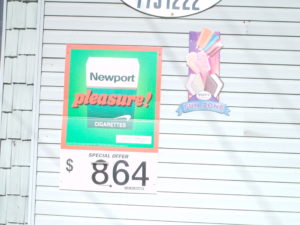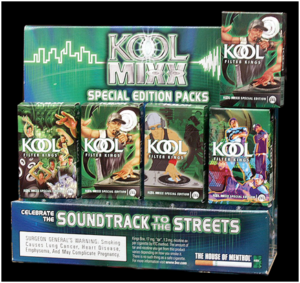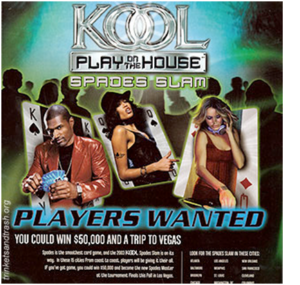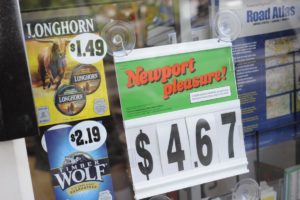Menthol
On April 28, 2022, the FDA announced a proposed rule to prohibit menthol as a characterizing flavor in cigarettes, as well as prohibit menthol and all other characterizing flavors in cigars. The docket for public comment on these two rules received nearly 250,000 comments altogether. You can search and view all submitted comments here for rule on menthol cigarettes and here for the flavored cigars rule.
- Read the FDA’s full press release here.
- Read the proposed tobacco product standard for menthol in cigarettes and submit comments here.
- Read the proposed tobacco product standard for characterizing flavors in cigars and submit comments here.
- FDA Fact Sheet: Proposed product standards to prohibit menthol as a characterizing flavor in cigarettes and all characterizing flavors (other than tobacco) in cigars
While this is a major step forward for public health, health equity, and the commercial tobacco endgame, the processes for finalizing and implementing these rules could take years, especially with delays from likely tobacco industry litigation. State and local action to prohibit the sale of menthol cigarettes and all other tobacco products remains critical and can save lives and prevent addiction now. Click on the following topics to learn more:
- What is Menthol and Why Does it Matter?
- Policy
- “Non-Menthol” Menthol and Synthetic Cooling Agents
- Resources
What is Menthol and Why Does it Matter?
Menthol is a flavor additive used in medicines, candies, and a number of other products, including tobacco products. While it can be derived from mint plants or synthetically made, it provides a cooling sensation and minty flavor.[1]
Menthol makes tobacco products easier to start, harder to quit, and tobacco companies have targeted its marketing to African Americans and other marginalized groups across the country for decades, contributing to disparities in tobacco product use and subsequent harm. Between 1980 and 2018, menthol cigarettes slowed the decline of smoking prevalence by 2.6% and were responsible for 10.1 million extra smokers, 3 million life years lost, and 378,000 premature deaths.[34] With the tobacco industry’s relentless targeted marketing of menthol cigarettes to the African American community, a disproportionate amount of the harm from menthol has also fallen on African Americans. While 12% of the US population is African American, African Americans account for 41% of the premature deaths and 50% of the life-years lost during this same time period.[38]
Menthol and Tobacco Use Initiation
Menthol is linked to higher rates of tobacco use initiation.[4] The cooling sensation helps mask the harshness of the smoke and tobacco taste. It can also cause users to inhale more deeply and become more dependent on nicotine as they inhale more of it, making it harder for users to quit.[5,6] In addition, according to a Tobacco Products Scientific Advisory Committee report on menthol, the “distinct sensory characteristics of menthol may enhance the addictiveness of menthol cigarettes.”

How Common is Menthol?
Menthol cigarettes comprise about 35% of the US market [7] and are widely available, sold in 98.6% of tobacco retailers. They are also the most advertised product on store exteriors.[8] They are usually easily recognized by their green or blue colored packaging. Menthol cigarette marketing targets a range of groups including African Americans, other communities of color, youth, and women, in particular.[9]
Due to the tobacco industry’s extensive and targeted marketing to African American communities, menthol cigarettes are most popular among people who are African American and smoke, 85% of whom smoke menthol cigarettes.[10] Only about 22% people who are white and smoke prefer menthol.[11] Since 2011, sales of menthol cigarettes have increased, and increasing numbers of people who are Asian & Hispanic who smoke are preferring menthol over non-menthol.[12,13] About 50% of people who are Hispanic and smoke use menthol cigarettes.[7] The tobacco industry has also extensively marketed menthol cigarettes to LGBTQ+ communities, and as a result, 51% of people who are lesbian/gay and smoke and 46% of people who are bisexual and smoke use menthol compared to 39% of people who are heterosexual and smoke.[14]
Menthol is also used as an additive in cigarettes and other products that are not marketed or labeled as menthol, and the amount of menthol can vary between products and brands.[15]
Youth Impact
Menthol cigarettes are also popular among youth. Half of all kids who have ever tried smoking started with menthol cigarettes, and in 2021, 41% of all current high school students who smoked used menthol cigarettes. [16]
Thanks to industry targeting, the disproportionate use of menthol also starts with youth, with 7 out of 10 African American youth who smoke using menthol cigarettes. [13]
Flavors like menthol may also contribute to initiation by making a product seem less harmful to adolescents.[17]
Initiation with flavored tobacco products, especially menthol, is especially concerning because young people who initiate smoking with menthol cigarettes are 80% more likely to become regular smokers and 25% more likely to become dependent on nicotine than young people who initiate smoking with non-menthol cigarettes.[18]
Learn more about the role of point-of-sale tobacco in youth initiation by reviewing the following:
- Evidence Summary – “Flavored Tobacco Products”
- Why Retail Tobacco Control is Important
Marketing towards African Americans

The tobacco industry has marketed their menthol products to Black and African Americans through targeted campaigns for decades, concentrating advertising and promotions in predominately African American neighborhoods and with campaigns that exploit cultural hallmarks and stereotypes. In the 1950s, less than 10% of Black people who smoked used menthol cigarettes. Today, thanks to industry targeting, that number is 85%.
Data shows that tobacco retailers within predominately African American areas are 2-3 times more likely to display interior and exterior advertisements than stores in areas with lower African American populations.[19] In addition, research has shown Newport (menthol) cigarettes to be cheaper in geographic areas with a higher proportion of African American residents.[20, 21] For example, an analysis of tobacco pricing survey data at the block group level collected in Boston between July 2015 and June 2016 found that for every 10% increase in the proportion of black residents, prices for menthol cigarettes decreased by 3 cents. Additionally, for every 10% increase in the proportion of black residents, the proportion of retailers selling menthol cigarettes at a price at least 25 cents below the established minimum price rose by 19%.[22]
The first concerted minority advertising push took place during the early 1970’s. During this time, major tobacco companies fought for share of the young urban African American market in what has been coined the “Menthol Wars”. Rival companies noticed Kool’s popularity in the African American market niche, and began vying for brand loyalty and profit. What started as a niche market has, over time, become a highly valued target audience segment for tobacco advertising, as discussed in these Phillip Morris documents about their Black Marketing Task Force.
During the Menthol War era, tobacco companies also began taking into account the physical attributes of stores in low-income minority communities in order to design the physical characteristics of their POS promotional campaigns. For example, in 1984, Phillip Morris released a series of window display ads with suction cups on them so that they could be placed behind bulletproof windows and still be seen by consumers. Additionally, displays, originally designed for larger stores, were re-designed and scaled down to fit better in smaller inner-city convenience stores, as part of Phillip Morris’s Ethnic Program Development. A 2013 study of Washington D.C. tobacco retailers found that retailers within predominately African American areas of the city were 2-3 times more likely to display interior and exterior advertisements than stores in areas with lower African American populations.[23] A systematic review found more menthol marketing in areas with higher numbers of low-income and black residents.[24] A recent study in both rural and urban Ohio found a higher prevalence of ads for cigarillos, cigars, and e-cigarettes in African American communities and found that urban, disadvantaged, African American communities had advertisements for more types of tobacco products overall.[25] In addition, research has shown Newport (menthol) cigarettes to be cheaper and more often discounted in geographic areas with a higher proportion of African American residents.[26, 39]

Wright, former Trade Marketing Manager and Controlling Manager of Brown and Williamson (tobacco company), discusses the importance of using price discounts in low-income African American neighborhoods with high menthol sales deemed as, “focus communities.”[27] Wright explains that a higher number of interior and exterior ads showcasing mentholated tobacco products were displayed in retail outlets located in “focus communities.” The use of price discounts and retailer incentive programs were also used to establish Kool’s presence at the point of sale. Kool’s share of market for mentholated products increased in stores where Kool offered a Buy-One-Get-One free promotion.[28] The use of these price cutting strategies coupled with strategic POS brand presence such as flashy colors, motorized displays, plastic countertop mats, and more mentholated product pack facings allowed for Kool to gain ground with African American consumers.[29]
Communities like San Francisco and Oakland, CA are restricting the sale of flavored tobacco products including menthol. The tobacco industry is working hard to prevent these menthol bans, and are sending well-known Black organizational leaders into Black communities to convince them that a menthol ban would work to their detriment. Learn more about these tobacco industry-funded events by reading “A Discussion on Menthol Bans & Criminalization of Black Communities.” Learn more more about the tobacco industry’s exploitation of the Black community through front groups, distortion, and corporate giving in this Public Health Law Center resource: The Tobacco Industry & The Black Community: The Targeting of African Americans.
Still today, studies show that more point of sale menthol marketing is found in areas with higher numbers of African American residents.[30] This marketing works. CDC MMWR data shows that 60% of African American youth prefer Newport, a brand of menthol cigarettes, compared to 22% of white youth.[31] Learn more about menthol marketing to Black communities by watching the videos below.
For more information, review the following:
- Black Lives Black Lungs
- CDC OSH Webinar: POS Strategies Guide and Tobacco Control and Social Justice: What’s Menthol Got To Do With It?
Policy
Federal
While the 2009 Family Smoking Prevention and Tobacco Control Act exempted menthol from the ban on flavored cigarettes, it also gave the FDA the power to prohibit the use of menthol in tobacco products if the standard would be “appropriate for public health.” The act also created the Tobacco Products Scientific Advisory Committee (TPSAC) and directed the group to report on the “impact of the use of menthol on the public health.” The resulting report, issued in 2011 found that, removing menthol cigarettes from the marketplace would benefit public health. They estimate that the effects of such a ban would include:
-
-
- 39% of people who smoke menthol cigarettes would quit
- 47% of African Americans who smoke menthol cigarettes would quit
- preventing over 17,000 fewer premature deaths by 2020
- preventing nearly 2.3 million people from initiating smoking by 2020 [32]
-
After the FDA did not take action on their own conclusion that removing menthol would benefit the public health, in April, 2013, the Public Health Law Center and 18 other organizations submitted a citizen petition to the FDA calling on the agency to add menthol to the list of characterizing flavors. In July 2013, the FDA released a non-binding advance notice of proposed rulemaking of the potential regulation of menthol in cigarettes and received over 174,000 public comments, but took no further action.
The tobacco industry sued the FDA over use of the TPSAC report, challenging the integrity of TPSAC, but a January 15, 2016 court decision allows the FDA to use the report as evidence and take action o n menthol.
n menthol.
While the 2016 deeming regulations, as originally proposed by the FDA, included language that would have included menthol as a “characterizing flavor” the White House Office of Management and Budget stripped that language along with other statements on the harmful effects of menthol from the enacted regulations.
In August 2017 the FDA announced their intention to issue another advance notice of proposed rule-making (ANPRM) to seek public comment on the role that flavors in tobacco products—including menthol—play in attracting youth, as well as the role they may play in helping some smokers switch to potentially less harmful forms of nicotine delivery. The agency officially issued the ANPRM on the regulation of flavored tobacco products on March 20th, 2018 for a 3-month public comment period. On November 15, 2018 the FDA announced that they would issue a Notice of Proposed Rulemaking to ban menthol in cigarettes, cigars, and any other combustible tobacco product. However, when no further action had been taken to move that policy forward, the African American Tobacco Control Leadership Council (AATCLC) and Action on Smoking and Health (ASH) filed a lawsuit against the Food and Drug Administration (FDA), compelling the FDA to add menthol to the list of characterizing flavors banned in tobacco products. The current lawsuit admonished the negligence of the FDA and implored the agency to finally take meaningful action against a product that is harming thee public, and disproportionately Black and Brown Americans. In January 2021, the Public Health Law Center also submitted a supplement to their 2013 Menthol Citizen Petition asking the FDA to add menthol to the list of prohibited characterizing flavors. On April 29, 2021 in response to the lawsuit and citizen petition, the FDA announced their intention to issue a product standards this year banning menthol cigarettes as well as one banning all flavored cigars. On April 28, 2022, the FDA announced a proposed rule to prohibit menthol as a characterizing flavor in cigarettes, as well as prohibit menthol and all other characterizing flavors in cigars. Public comment on the proposed rules was open through July 7th. The FDA also held two public listening sessions on the proposed rules in June.
- Read the FDA’s full press release here.
- Read the proposed tobacco product standard for menthol in cigarettes
- Read the proposed tobacco product standard for characterizing flavors in cigars
- FDA Fact Sheet: Proposed product standards to prohibit menthol as a characterizing flavor in cigarettes and all characterizing flavors (other than tobacco) in cigars
While this is a major step forward for public health, health equity, and the commercial tobacco endgame, the processes for finalizing and implementing these rules could take years, especially with delays from likely tobacco industry litigation. When these rules are finalized and implemented, research shows there will be many public health benefits:
- According to a 2016 study, a nation-wide ban on menthol has the potential to save hundreds of thousands of lives, and nearly 1/3 of them would be Black lives.[33]
- In a 2023 published study, researchers simulated the public health impact of U.S. menthol ban and found with a ban, overall smoking would decline by 15% by 2026, and by 2060, smoking and vaping-attributable deaths would decline by 5% and life-years lost by 8.8%.[34]
These findings show the lives saved with a national ban on menthol cigarettes and cigars. State and local action to prohibit the sale of menthol cigarettes and all other tobacco products remains critical and can save lives and prevent addiction now before a nationwide ban.
State
In November 2019, Massachusetts became the first state to prohibit the sale of all flavored tobacco products, including menthol cigarettes and e-cigarettes. The only exception to the law is that flavored tobacco products can still be sold at licensed smoking bars such as cigar bars and hookah lounges, though consumption must occur on-site. The law went into effect in June 2020.
In August 2020, California passed a law prohibiting the sale of most flavored tobacco products, making it the second state to prohibit the sale of menthol cigarettes and the fourth to prohibit the sale of flavored e-cigarettes. The only products exempt from the policy are loose leaf tobacco, “premium” cigars, and hookah tobacco. While the policy was set to go into effect on January 1, 2021, a petition sponsored by the tobacco industry seeking to challenge the law sent it to ballot referendum. In November 2022, California voters upheld the state’s ban on the sale of most flavored tobacco products with over 63% of the vote in that referendum. While the tobacco industry promptly filed a lawsuit to stop the ban, the United States Supreme Court refused to grant their request for an injunction, allowing the ban to finally go into effect on December 21, 2022. The industry didn’t win, but they were able to delay the policy’s implementation by almost two years and make nearly $800 million on their deadly menthol cigarettes alone in the process.
Local
At least 190 local communities across the country have restricted or prohibited the sale of menthol cigarettes to help reduce the health issues and disparities that come with the targeted marketing of menthol products to youth and African Americans. Localities started with incremental restrictions, but comprehensive bans have been able to withstand all tobacco industry challenges, and an increasing number of communities are implementing them from the start. Some historic firsts for incremental progress at the local level include:
- In 2013, Chicago, IL became the first city to ban all flavored tobacco products, including menthol, from within 500 ft. of schools,[35] and Berkeley, CA followed suit with a restriction on sale within 600 ft. of schools in 2015.
- In 2016, Santa Clara County, CA became the first municipality to restrict menthol cigarettes and other flavored tobacco products to retailers that exclusively serve people age 21 and up.[36] This approach was also adopted by cities included Minneapolis and St. Paul, MN, which started with restricting flavored tobacco products except menthol to adult-only retailers but later expanded the policy to include menthol cigarettes as well.
- Also in 2016, Yolo County, CA banned all flavored tobacco products, including menthol, in its unincorporated areas.[37]
- In 2017, San Francisco, CA has passed a city-wide ban on the sale of menthol cigarettes and all other flavored tobacco products. While the tobacco industry forced the policy to a voter referendum, residents voted 68% to 31% to uphold the policy in June 2018. Read more about the progress of the San Francisco proposal here and the groundwork involved in getting it passed here.
Local Menthol Policy Case Studies: Minneapolis, St. Paul, and Duluth, MN and Oakland, CA
This recorded webinar offers case studies for successfully passed local policies restricting the sale of menthol tobacco products. Find out Minneapolis, St. Paul, and Oakland were able to pass their policies, who helped, lessons learned, and more:
Check out a case study on the menthol policies passed in Minneapolis, St. Paul, and Duluth, MN here.
“Non-Menthol” Menthol and Synthetic Cooling Agents
In response to California and Massachusetts’ statewide bans on the sale of flavored tobacco products, including menthol cigarettes, RJ Reynolds debuted new “cool” and “crisp” cigarettes that use a synthetic coolant instead of menthol in anticipation of a federal ban on menthol cigarettes. In light of this industry tactic, the Public Health Law Center also updated its definition of flavored tobacco to specify that flavor includes sensation. Read their commentary and updated definition here.
Cigarettes are not the only products using synthetic cooling agents – research shows many e-cigarettes contain them as well. And similar to how menthol is used in almost all cigarettes at some level, synthetic coolants are also present in e-cigarettes that are fruity or candy-flavored as well as mint or menthol-flavored e-cigarettes.
Jurisdictions can adopt more comprehensive language going forward to clearly prohibit these type of cooling agents as flavorings as well.
Resources
- Stopping Menthol, Saving Lives: Ending Big Tobacco’s Predatory Marketing to Black Communities
- How Minneapolis, St. Paul and Duluth Passed Nation-Leading Menthol Tobacco Sales Restrictions: Case Studies from Minnesota
- Public Health Law Center’s
- Flavored Tobacco Toolkit
- Restricting the Sale of Flavored Tobacco Products: Sample Language
- Supplement to FDA citizen petition, “Prohibit Menthol as a Characterizing Flavoring of Cigarettes and Cigarette Smoke”
- US Sales Restrictions on Flavored Tobacco Products
- FDA Menthol Timeline
- Chicago’s Regulation of Menthol Flavored Tobacco Products: A Case Study
- Leading from Up North: How Canada is Solving the Menthol Tobacco Problem
- Webinar: From Canada to California: Building Momentum on Menthol Restrictions
- Regulating Flavored Tobacco Products
- Center for Black Health and Equity: The Menthol Issue
- African American Tobacco Control Leadership Council: Finishing the Fight
- Truth Initiative’s Menthol and flavor policies: Lessons from the field
- US Department of Health and Human Services- Menthol Report
- CDC Office on Smoking and Health’s:
- WHO’s Case Studies for Regulatory Approaches to Tobacco Products: Menthol in tobacco products
- Finished with Menthol: An Evidence-Based Policy Option that will Save Lives
- Tobacconomics:
- Menthol Media Campaigns:
- Chicago: Don’t Get Burned
- Minneapolis/St. Paul: Beautiful Lie, Ugly Truth
- Pasadena’s REACH campaign


